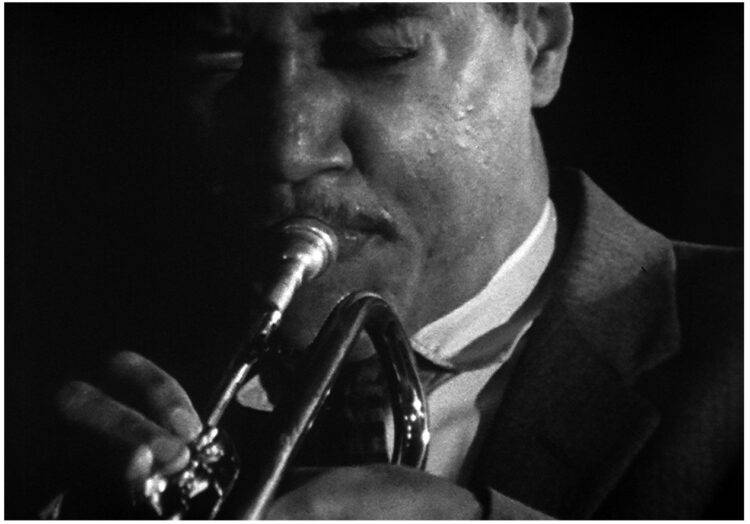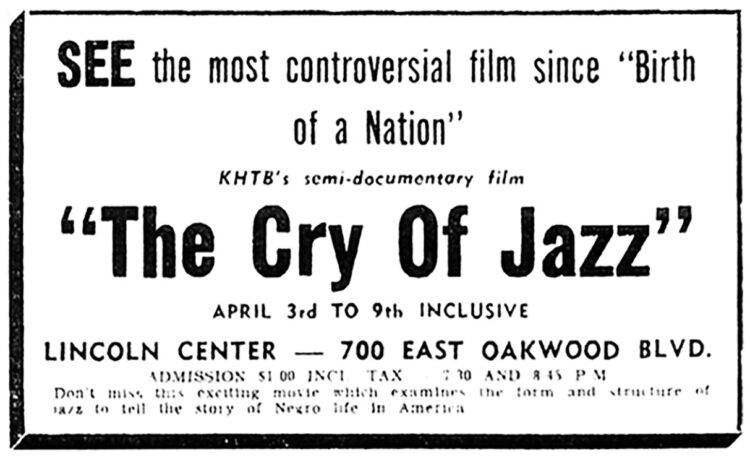
What comes to mind when you think of jazz? A horn player and a saxophone playing with melody lines? A club from a bygone era? Something reminiscent of the past even when played today on your iPhone speakers?
“The Cry of Jazz,” from 1959 is a black-and-white feature with a runtime of 34 minutes that transports the audience back to a critical period in history, similarly to how jazz can. The documentary, featuring a cast of six and performances by jazz luminaries like Sun Ra, boldly addressed the intricate relationship between jazz and the African American community post-World War II. In the film, the narrator, scholar Alex (played by Dorothea Horton), delivers a passionate and prophetic monologue that foretells the decline of jazz as a genre and its ripple effect on the social climate.
Through a mix of dramatic dialogue, music, and documentary footage, the film presents a thought-provoking commentary on jazz’s cultural and social significance. The film has rightfully earned acclaim for its profound cultural insights, securing its place as a significant work in the annals of cinematic history.
The film’s unconventional blend of interviews, dramatized scenes, and jazz performances challenged filmmaking norms artistically. Its assertion of jazz as a symbol of black identity clashed with prevailing attitudes. The creator, Edward Bland explains how certain jazz critics voiced disapproval of the film’s portrayal of jazz as predominantly rooted in black culture and its dismissal of the contributions made by white musicians to the genre.

By presenting jazz as a symbol of African American cultural defiance, the film confronted the idealized notion of jazz as a harmonious medium of racial unity. It addressed themes of racial oppression, cultural appropriation, and the exploitation of African American art forms by white society. At the time of its release, some viewers found the film’s uncompromising critique of racism and cultural hegemony unsettling or confrontational.
While the film doesn’t explicitly address the notion of jazz’s death, it does confront challenges to its authenticity and integrity, suggesting that jazz’s survival depends on preserving its connection to its African American origins and resisting cultural commodification. Thus, in the context of discussions about the death of jazz, “The Cry of Jazz” can be seen as advocating for the preservation and revitalization of the genre through an affirmation of its cultural roots and significance.
Gene Siskel screened “The Cry of Jazz” in collaboration with the Coalition of Black Restorative Artists at SAIC during their 29th Annual Black Harvest Film Festival last fall. As the credits rolled, a haunting wail emerged from the audience. The atmosphere was charged with emotion as a woman rose from her seat and moved gracefully through the darkened theater, her melodic wails filling the space. The stage beneath the screen became a focal point as two men joined her — one strumming a large bass, the other singing. The woman approached the front stage beneath the screen, revealing herself as Angel Bat Dawid.
Joined by a tambourine, clarinet, flute, and piano, the three performers of African descent alternated between instruments, infusing the room with an ode to jazz. Dawid is a Chicago-based avant-garde musician known for her innovative approach to jazz. She excels in playing multiple instruments and vocals, creating unique and emotionally resonant musical experiences. With a blend of improvisation and spoken word, Dawid addresses societal issues through her art, challenging audiences to think deeply while celebrating the cultural richness of jazz.
Dawid’s performance at “The Cry of Jazz” showcase served as a mourning ritual for the death of jazz, echoing the film’s themes. She challenged the audience to grapple with the movie’s controversial nature when it was released and its enduring relevance today. The audience was provided with instruments and participated in different calls and responses. She then asked white audience members onto the stage to discuss their perceptions of the film. For many long minutes, no one volunteered. Dawid questioned them, contesting someone to be brave enough to face her and discuss the contents of the film and the feelings of white guilt that many experience when discussing these matters. Dawid’s words addressed the perception of art, highlighting the tendency to categorize art as “black” or “white.”
The visual elements accompanying Dawid’s performance added another layer to the narrative. Images flashed on the cinematic screen, illustrating how jazz played a pivotal role in forming R&B and gospel music. Clips played different people, pastors, and musicians speaking about jazz and gospel. The cyclical nature of art and culture unfolded before our eyes, revealing the interconnectedness of musical genres and their profound impact on society.
Through the screening of “The Cry of Jazz” and Angel Bat Dawid’s performance, I experienced a unique and immersive experience. It was not just a showcase of artistic expression but a profound exploration of jazz’s cultural, social, and historical dimensions. As an art student, I left the festival with a deeper appreciation for the power of art to challenge, mourn, and transcend boundaries. The evening was a testament to the enduring legacy of jazz and its ability to evoke emotions that resonate across time and space.
This film proves the cyclical nature of art, music, and film. “The Cry of Jazz” encourages viewers to rethink conventional narratives about jazz and its place in American society, challenging us to consider the broader socio-political context in which music is created and consumed. In a time when conversations about representation, diversity, and social justice are prominent, the film serves as a valuable reminder of the complex historical and cultural forces that shape our understanding of music and identity.
Overall, “The Cry of Jazz” remains a thought-provoking and timely work that invites audiences to engage critically with issues of race, culture, and artistic expression. Viewers can watch the whole film on YouTube or on the Library of Congress website.







